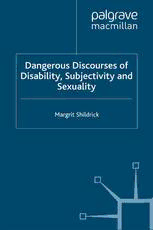
Dangerous Discourses of Disability, Subjectivity and Sexuality PDF
Preview Dangerous Discourses of Disability, Subjectivity and Sexuality
Dangerous Discourses of Disability, Subjectivity and Sexuality AlsobyMargritShildrick LEAKYBODIESANDBOUNDARIES EMBODYINGTHEMONSTER ETHICSOFTHEBODY(co-edited) Dangerous Discourses of Disability, Subjectivity and Sexuality Margrit Shildrick Queen’sUniversityBelfast,UK ©MargritShildrick2009 Softcover reprint of the hardcover 1st edition 2009 978-0-230-21056-1 Allrightsreserved.Noreproduction,copyortransmissionofthis publicationmaybemadewithoutwrittenpermission. Noportionofthispublicationmaybereproduced,copiedortransmitted savewithwrittenpermissionorinaccordancewiththeprovisionsofthe Copyright,DesignsandPatentsAct1988,orunderthetermsofanylicence permittinglimitedcopyingissuedbytheCopyrightLicensingAgency, SaffronHouse,6-10KirbyStreet,LondonEC1N8TS. Anypersonwhodoesanyunauthorizedactinrelationtothispublication maybeliabletocriminalprosecutionandcivilclaimsfordamages. Theauthorhasassertedherrighttobeidentified astheauthorofthisworkinaccordancewiththeCopyright, DesignsandPatentsAct1988. Firstpublished2009by PALGRAVEMACMILLAN PalgraveMacmillanintheUKisanimprintofMacmillanPublishersLimited, registeredinEngland,companynumber785998,ofHoundmills,Basingstoke, HampshireRG216XS. PalgraveMacmillanintheUSisadivisionofStMartin’sPressLLC, 175FifthAvenue,NewYork,NY10010. PalgraveMacmillanistheglobalacademicimprintoftheabovecompanies andhascompaniesandrepresentativesthroughouttheworld. Palgrave®andMacmillan®areregisteredtrademarksintheUnitedStates, theUnitedKingdom,Europeandothercountries. ISBN 978-1-349-30312-0 ISBN 978-0-230-24464-1 (eBook) DOI 10.1057/9780230244641 Thisbookisprintedonpapersuitableforrecyclingandmadefromfully managedandsustainedforestsources.Logging,pulpingandmanufacturing processesareexpectedtoconformtotheenvironmentalregulationsofthe countryoforigin. AcataloguerecordforthisbookisavailablefromtheBritishLibrary. LibraryofCongressCataloging-in-PublicationData Shildrick,Margrit. Dangerousdiscoursesofdisability,subjectivityandsexuality/ MargritShildrick. p. cm. Includesbibliographicalreferencesandindex. ISBN 978-1-349-30312-0 (alk. paper) 1. Peoplewithdisabilities. 2. Marginality,Social. I. Title. HV1568.S4542009 305.9(cid:2)08—dc22 2009013616 10 9 8 7 6 5 4 3 2 1 18 17 16 15 14 13 12 11 10 09 Contents Acknowledgements vi Introduction 1 1 Corporealities 17 2 Genealogies 39 3 ContestedPleasuresandGovernmentality 60 4 Sexuality,SubjectivityandAnxiety 81 5 TransgressingtheLaw 103 6 QueerPleasures 125 7 GlobalCorporealities 146 Conclusion:ThinkingDifferently 170 Notes 178 Bibliography 193 Index 206 v Acknowledgements Themanuscriptiscompleteandreadytosendofftothepublisher,my studyfloorisfinallyclearedofaccumulatedreferencematerial,andnow comesthealwaysdifficulttaskofwritingtheacknowledgements.Itend towriteinextended,intense,andisolatedstretches,butsomuchintel- lectual,emotional,andevenphysicalworkgoesintogettingtothisstage oftheprocessthatnothingIsayherewillbefullyadequate. During the years I have been pursuing this project I have been for- tunateenoughtohavetravelledandworkedorheldresearchpositions widely beyond my home location, and I’m grateful to all those who provided time, space, and funding. My thanks go especially to Ailbhe Smyth of University College Dublin for her unwavering support, and to all the participants in the three years of the open seminar series, Advanced Feminist Theory, which provided the opportunity for me to try out some of the nascent ideas that later developed into chap- ters in Dangerous Discourses. During much of the same period I was co-editing a book on feminist corporeal ethics with Roxanne Mykitiuk of Osgoode Hall Law School, Toronto, who made the inspired sug- gestion that I take up a visiting research scholarship at Cornell Law School under the direction of Martha Fineman, who is well-known as a great supporter of disability scholarship. The Toronto connec- tion itself produced further openings, including a wonderful semester teaching at York University on the newly convened Masters in Crit- ical Disability Studies. The director of the programme, Marcia Rioux, despite her own very different approach to disability, gave me all encouragement to work with the students in a way that surely over- turned some cherished doxa. The vigorous response of the course participants challenged me to think more clearly and effectively, to the extent that it remains my own most valuable period of teach- ing. Since then, as an adjunct professor of disability studies at York, I have supervised several excellent graduate dissertations with outstand- ingcontributionsfromLoreeErickson,JulieDevaney,JenPaterson,and Kelly Fritsch. A series of visiting fellowships at HCTP and Centre for Women’sHealth–bothinstitutionsofUniversityofToronto–brought me into close contact with Pat McKeever and Gillian Einstein, both highly innovative thinkers; while time at the Centre for Somatechnics atMacquarieUniversityandatSydneyLawSchoolwasenabledbyNikki vi Acknowledgements vii SullivanandIsabelKarpinrespectively.Allthosementioned,andmany more, have played a significant role in the process of my writing this book. BackintheUnitedKingdom,mymajorthanksonbothanintellectual andpersonallevelareduetoJanetPricewhohascollaboratedwithme onnumerouspresentationsandpublications.Herwillingnesstopursue all sorts of unorthodox ideas has been a mainstay in the development of the modes of thinking that inform Dangerous Discourses, though I hesitatetosayshewouldagreewithitall.Manyotherfriendsandcol- leagues have contributed in multiple ways, including Holliday Tyson andNancyHalifaxwhohavemadeTorontohomefromhome.Finally, theprojectsimplywouldnothavecometofruitionwithouttheongoing andunquestioningsupportandgenerosityofmypartner,LisDavidson. Aswithmostsingle-authoredbooks,someofthematerialhasalready seenthelightofdayinotherforms.Severalchaptersarebasedonpre- viouslypublishedarticles,whichhavebeentoagreaterorlesserextent reworkedandrecontextualised,andoftendistributedovertwoormore locations. In the era of postmodernity and cyberspace nothing is ever final, and I have incorporated some work from my own prior publi- cations in Cultural Studies 2005, 19. 6, Critical Quarterly 2005, 47. 3, Sexuality Research and Social Policy 2007, 3. 3, SCAN 2004, 1.3, Studies in Gender and Sexuality 2007, 8. 3, and from a joint paper with Janet Price that appeared in Rhizomes 2005, 11. I gratefully acknowledge all permissionsgranted. Introduction Why is it that at the beginning of the twenty-first century – with its multiple geo-political insecurities and anxieties, its distinctly ambiva- lent expectations of the future, and its growing awareness of internal pressures–thewesternworldanditsdevelopedcounterpartsshouldbe so unsettled by anomalous embodiment? What is it about the variant morphologyofintra-humandifferencethatissodisturbingastoinvoke in the self-defined mainstream not simply a reluctance to enter into fullrelationship,butapositiveturningawayandsilencingoftheunac- ceptedother?Forsuchadisengagementtopersistinthefaceofappar- entlymoreweightyglobalconcernsspeaksnottoanover-investmentin thelocalandindividual,akindofdisplacedanxietyeven–thoughthat cannotbeentirelydiscounted–buttotheextraordinarysignificanceof humancorporeality.Tobenamedasdifferentlyembodiedisalreadyto occupy a place that is defined as exceptional to some putative norm, rather than to simply represent one position among a multiplicity of possibilities. The self-evidence of differential form across human mor- phologyasawholeisputasideinfavourofadiscourseinwhichsome peoplearetakentoinherentlyexceedtheboundariesofwhatcountsas normative embodiment. In this text, I concentrate on the continuing discursive exclusion of disability within western and western-inflected societies,andarguethatattheverysametimethatsuchstatesaremak- ingtremendousstridestowardstheformalintegrationofdisabledpeople intothe rights, obligations,and expectations of normativecitizenship, acounter-trendofsegregationisequallyinplay.Thetitleofthisbook– DangerousDiscourses–isnorhetoricalflourish,butanindicationofthe depthofanxietythatengagementwithdisabilityelicits. My thesis is that disabled people1 continue to endure broad cultural discriminationandalienation,notsomuchfortheirdifference(which 1 2 DangerousDiscourses may of course be hidden) but because their form of living in the body lays bare the psycho-social imaginary that sustains modernist under- standings of what it is to be a subject. Where physical and mental autonomy,theabilitytothinkrationallyandimpartially,andinterper- sonal separation and distinction are the valued attributes of western subjectivity, then any compromise of control over one’s own body, any indication of interdependency and connectivity, or of corporeal instability, are the occasion – for the normative majority – of a deep- seated anxiety that devalues difference. In an earlier book, Embodying theMonster,Itracedthatnegativetrajectorythroughthehistoryofthe monstrous into present-day manifestations that implicate a variety of non-normative forms of embodiment: from conjoined twins, through displaced persons like refugees, to the futuristic cyborg. Yet for all the narrative of violence, oppression, and disavowal of the monstrous, the coincident exposure of a motivating and irreducible vulnerability attheheartofallhumanembodimentsignallednottheinevitabilityof rejection,butthepossibilityofwhatHaraway(1992)termsa‘regenera- tivepolitics’.Heropeningupof‘thepromisesofmonsters’giveshopeto adifferentfuture.Intakingupmypresentfocusonstatesofdisability,I reiteratesomeofthesamethemes,butinamoresubstantiveandevery- day contextthatimbricates with,yet fundamentallycritiques,a recent historyofdisabilitypoliticsthathasalsosoughttooverturnthenorma- tiveparadigmsthatdeterminewhoshallbevaluedandwhonot.Against the standard demands for an extension and solidification of rights for disabled people, and for a more thoroughgoing inclusion of their spe- cificinterestsinculturalproduction,Iturninsteadtoaninvestigationof whatitisthatcontinuestoimpedetheevolutionofequitableconditions ofpossibility.Suchamodeofthinkingmarkswhatisoftentermed‘crit- icaldisabilitystudies’,arelativelyrecentdevelopment–withinwhichI situatemyownwork–thatisbroadlyalignedwithapostconventional theoretical approach. Its purpose is both to extend into new territory the achievements of working through a more modernist paradigm of disability, and where necessary to productively critique the limitations ofthatmodel. Before proceeding further it is necessary to ask what comprises the category of disability, or what I have less contentiously referred to as anomalous embodiment. Although some form of definitive answer is oftencalledfor–inacademianolessthanintermsofageneralpublic– it is one that I, along with many other critical disability theorists, and particularly those working within a postconventional framework, am reluctanttoprovide.Tosetoutanymutuallyagreedseriesofparameters
